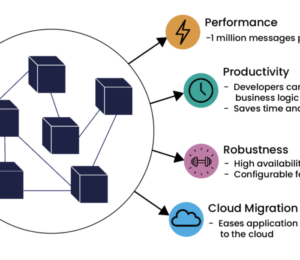🧱 Monolith or 🧩 Microservices in 2025?
- August 04, 2025
- 12148 Unique Views
- 3 min read
- Why developer happiness drives simpler, centralized architectures
- Why Developers Prefer It
- It's Not Always Binary
In recent years, the tech world has been buzzing with debates about architecture choices. However, 2025 offers a more balanced perspective.
Simplicity, developer experience, and maintainability are reshaping how teams design software.
From Infrastructure as Code (IaC) to "vibecoding" culture, and from startups to enterprises, many rethink their position on the monolith vs microservices 2025 spectrum.
So, what has actually changed?
🔵⚪⚪⚪⚪⚪
🔁 Terraform and IaC: Changing Architecture with Confidence
How Infrastructure as Code helps teams adapt architecture efficiently
Infrastructure as Code tools like Terraform make architecture changes easier. Nevertheless, the process is not effortless.
Why IaC Helps
- Firstly, infrastructure becomes versionable, allowing easier testing, validation, or rollback.
- Secondly, provisioning environments for proofs of concept is faster, thus reducing risks.
- Additionally, Terraform supports microservices with elements like networking, databases, and monitoring.
But Be Careful
- IaC does not solve problems in code organization or inter-service communication.
- Furthermore, many challenges remain organizational rather than infrastructural.
💡 Example: Refactoring a monolith into microservices goes far beyond just spinning up ECS or Kubernetes with Terraform.
🔗 Useful sources:
🔵🔵⚪⚪⚪⚪
🎧 Vibecoding Culture Favors Monorepos and Monoliths
Why developer happiness drives simpler, centralized architectures
Vibecoding—the focus on great developer experience—often favors centralized architectures like monoliths or monorepos.
Why Developers Prefer It
- One repository, one build, one entry point reduce friction and improve flow.
- Tools like hot reload, local tests, and integrated demos work more smoothly.
- Moreover, even microservice fans see value in recentralizing to speed development.
It's Not Always Binary
- A monorepo can still host microservices, depending on tooling like Nx, Turborepo, or Bazel.
- Also, microservices can be “vibe-friendly” with tools such as Tilt, devcontainers, and nx-cloud.
💡 Example: Shopify uses microservices but invests heavily in developer experience to keep the flow smooth.
🔗 Useful sources:
🔵🔵🔵⚪⚪⚪
🏢 Enterprises Now Embrace the Monolith Party
Why big companies prefer modular monoliths or packaged microservices
Surprisingly, many large enterprises now return to modular monoliths or packaged microservices like moduliths and self-contained systems.
Why This Is Happening
- Microservices bring high coordination, deployment, and security costs.
- When organizations are unprepared, the return on investment often falls short.
- Enterprises prioritize stability, simplicity, and traceability—qualities monoliths offer.
💡 Example: Amazon, known for microservices, is now grouping services into well-bounded contexts.
🔗 Useful sources:
🔵🔵🔵🔵⚪⚪
🔄 2025 Marks a Shift from Red to Blue Mindsets
How priorities shifted from 2024 to 2025 in software architecture
Why would someone who chose “red” in 2024 choose “blue” in 2025? Because priorities changed significantly.
| Factor | 2024: Red | 2025: Blue |
|---|---|---|
| 📦 Packaging | Kubernetes, Lambdas, Microservices | Modulith, Spring Boot, Dagger |
| 🧑💻 DevEx | Complex tools, disconnected teams | Fullstack flow, unified developer experience |
| 🏛️ Org Model | Specialized teams | End-to-end feature teams |
| 🧾 Cost | Expensive observability and CI/CD | Simplicity leading to lower costs |
| 🧠 Vision | Hype-driven scalability | Focus on resilience and clarity |
In 2025, sustainability and clarity matter more than theoretical elasticity.
🔗 Further reading:
🔵🔵🔵🔵🔵⚪
🧭 Conclusion – From Hype to Balance
Why the debate is about context and balance, not choosing sides
The monolith vs microservices 2025 debate is not about choosing sides. Instead, it is about making context-driven decisions.
In 2024, teams chased independence and scalability with microservices. In 2025, they rediscover simplicity and developer experience often lead to more sustainable systems.
Moreover, modern tools like Terraform, devcontainers, and powerful CI/CD platforms allow revisiting architecture with intention.
Whether working in a monolith, a modulith, or a well-tooled microservice ecosystem, balance, clarity, and team alignment matter most.
🎯 Maybe the future isn’t monolith or microservices—it’s the ability to move between them with purpose.
🔵🔵🔵🔵🔵🔵
🎓 Wanna level up your game with world-class Java and Spring certifications?
Check out these top-rated Udemy courses:
👉 OCP Java Developer Certification Prep
👉 Spring Professional Certification – 6 Full Practice Tests
Start mastering your future today! 🚀
Don’t Forget to Share This Post!









Comments (1)
Docker Adoption: 92% in IT, Only 30% Across Devs | byteiota
1 month ago[…] experts have reached consensus in 2025: below 10 developers, monoliths perform better and Docker adds complexity without clear benefits. […]